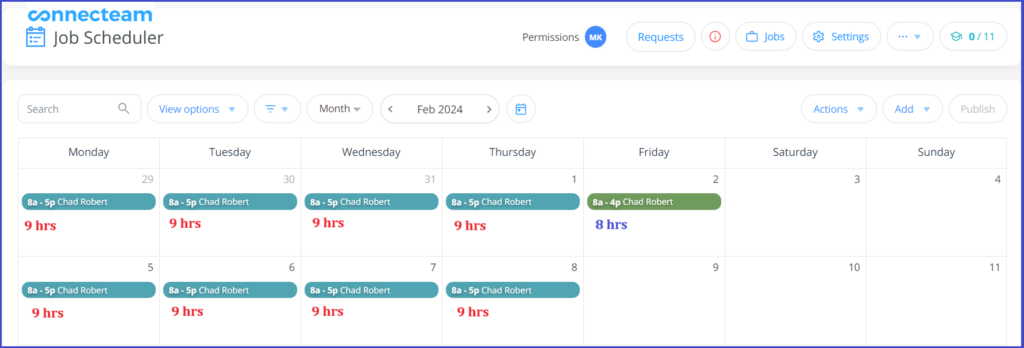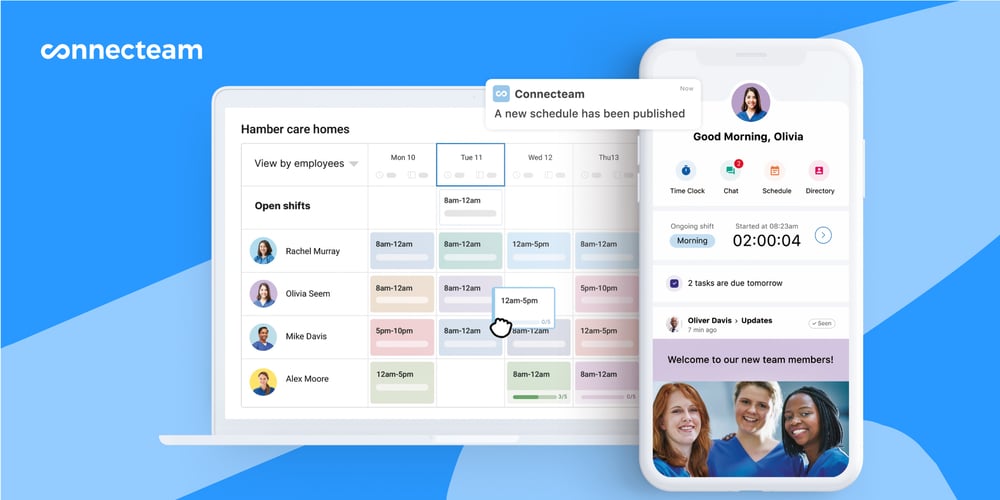Traditional 9-to-5 schedules often don’t align with modern employees’ needs, leading to burnout and decreased productivity.
Alternative work schedules (AWSs) offer the flexibility that today’s dynamic work environments demand, enhancing creativity and overall job satisfaction.
Below, I’ll walk you through various AWSs, their pros and cons, and industry suitability—and provide practical implementation tips.
Key Takeaways
- AWSs are non-traditional work arrangements that offer flexibility in work hours and locations to better align with employees’ personal needs and business requirements.
- Compressed schedules like the 4/10 and 9/80 allow employees to work full-time hours in fewer days, while flexible schedules like the Maxiflex and Gliding schedules can accommodate personal and professional needs.
- Implementing an AWS requires careful planning, clear policies, legal consideration, and ongoing communication to ensure it aligns with both business needs and employee expectations.
What Is an Alternative Work Schedule?
AWSs are work arrangements that deviate from the traditional 8-hour, 9-to-5, Monday-to-Friday schedule. These include flextime, compressed workweeks, remote work, and job sharing.
Benefits of Alternative Work Schedules
AWSs benefit employers and employees in various ways. The benefits depend on the chosen AWS and how it’s implemented.
Benefits for employers
- A wider talent pool: Flexibility can be a major selling point for potential hires and a reason for current employees to stay.
- Enhanced employee morale and satisfaction: Giving employees more control over their work schedules can increase happiness and well-being.
- Reduced absenteeism and turnover: Offering flexible scheduling options can decrease absenteeism, as employees can better balance work with personal responsibilities. This flexibility can also enhance job satisfaction, leading to lower turnover rates.
- Optimized use of office space: By staggering work hours or implementing remote work options, companies can reduce the need for large office spaces and potentially lower rent and utility costs.
Benefits for employees
- Improved work-life balance: Employees can balance work with personal commitments, reducing stress.
- Increased productivity: Flexible scheduling often results in higher efficiency and focus.
- Reduced commuting costs and time: Remote work arrangements eliminate the need for daily commutes, saving employees money and time.
- Increased job satisfaction: Control over hours of work can lead to greater job satisfaction, as employees feel more autonomy and involvement in managing their work lives.
- Reduced risk of burnout: Flexibility enables employees to manage their workloads and take breaks, preventing burnout.
This Might Interest You
Read our in-depth guide on 15 types of work schedules every manager must know.
5 Types of Alternative Work Schedules
- Compressed work schedules
- Flexible work schedules
- Remote work arrangements
- Job sharing
- Results-only work environment
Compressed work schedules
A compressed work schedule (CWS) allows employees to work more than the typical 8 hours in a day to complete a full week’s work in fewer days.
This type of schedule can be particularly beneficial in industries where long operational hours are required and can help cover extended open hours without additional staffing.
Let’s have a look at different types of CWSs.
4/10 schedule

In a 4/10 schedule, employees work 4 days each week, 10 hours per day. This totals 40 hours in a week. For example, they may work Monday through Thursday, with 3-day weekends every week.
This model enables businesses to extend their daily operational coverage while offering employees an extra day off each week.
9/80 schedule

This schedule allows employees to work 80 hours over 9 days instead of the traditional 10 days. A typical 9/80 example is working 9 hours per day for 8 workdays, and 8 hours on the 9th workday, with the 10th workday off. With this schedule, there’s a day off every other week.
12-hours

The 12-hour compressed work schedule alternates between 3 and 4-day workweeks, with employees working 12-hour shifts during their scheduled days. This structure allows for significant time off, typically providing employees 3 or 4 consecutive days of rest each week.
Pros of compressed work schedules
- Longer weekends can improve employee morale and work-life balance.
- Fewer operating days might mean cost savings on utilities.
- The ability to have lengthy focused, uninterrupted work time may increase productivity.
Cons of compressed work schedules
- Longer work days can lead to burnout or fatigue.
- Some employees find their productivity waning at the end of a long workday.
- Diminished work-life balance due to longer daily hours can affect overall employee well-being.
Pro Tip
Compressed workweeks are highly adaptable. Don’t limit yourself to standard models like the 9/80 or 4/10 schedule. Tailor them to meet the specific needs of your business and employees.
Suitable for: Healthcare, law enforcement and emergency services, manufacturing, tech and IT companies, and government offices.
Flexible work schedules
A flexible work schedule (FWS) offers employees more control over their working hours, allowing them to choose when they start and stop working—within limits.
Flexible schedules typically include 2 elements:
- Core hours: The hours when employees must be present.
- Flexible time band: The periods within the workday during which employees can choose their start and end their work hours.
Let’s explore different types of flexible schedules, from most to least flexible.
Maxiflex
Maxiflex is a highly flexible schedule that allows employees to vary their work hours significantly, including choosing when to start and finish work each day. They must fulfill their basic work requirement (a required number of hours per week or 2-week period).
For instance, one week, an employee might choose to work 9 hours Monday-Thursday and take a half-day on Friday. Then, they might adjust the next week’s schedule to fit personal obligations or workload variations.
This flexibility often excludes core hours—or defines very minimal core hours.
Variable week
Variable week schedules allow employees to alter the number of hours they work each day or week. They must meet the total required hours for a long period, such as a month.
In a variable week schedule, an employee might be required to complete 160 hours over a 4-week period. They might choose when and how long to work based on their workload and personal preferences. For example, they may work 40 hours one week, then 35 or 45 hours another week.
Variable day
In a variable day schedule, employees have the flexibility to vary their daily hours. This can include different start and end times each day based on their personal and work obligations, and work hours can differ each day.
Under this schedule, an employee must complete a total of 40 hours each workweek, maintaining a consistent total of 80 hours over the course of the biweekly pay period.
For example, an employee could work three 10-hour days and two 5-hour days in a week, making a total of 40 hours per week.
Gliding schedule
A Gliding schedule provides flexibility in the daily arrival and departure times. Under this arrangement, your employees must work 8 hours each day and 40 hours a week. While workers can vary the times they arrive and leave each day, they must be present during established core hours.
For example, if core hours are 10:00 am-2:00 pm, one employee could elect to work 7:00 am-3:00 pm one day and 9:00 am-5:00 pm another day.
Flexitour
A Flexitour schedule is similar to a gliding schedule but with more consistency. Your employees work 8 hours each day and 40 hours each week. However, unlike a gliding schedule where arrival and departure times can vary daily, in a Flexitour, their schedule remains the same every day.
Employees can change this fixed schedule only during formal opportunities you provide, such as during a scheduling review period. For example, if they choose to work 8:00 am-4:00 pm, this schedule will be fixed until the next opportunity to change it arises.
Pros of flexible work schedules
- Can boost employee satisfaction and retention.
- Accommodates personal needs/preferences.
- May increase productivity by letting employees work during their most effective hours.
Cons of flexible work schedules
- Varying schedules can present coordination and coverage challenges.
- Unclear policies or accountability can create the potential for abuse.
- Assessing performance can be more complex when employees work during off-peak hours.
Suitable for: Technology and IT, creative industries, customer service, consulting and finance, and academic and research institutions.
| Schedule Type | Features | Pros | Cons | Suitability |
| Maxiflex | Most flexible | Enhances employee autonomy | Is difficult to monitor | Project-based industries, independent tasks |
| Variable Week | Very flexible | Accommodates fluctuating workloads | Can complicate long-term project planning | Consulting or project management roles |
| Variable Day | Moderately flexible | Adapts daily to workload and personal needs | Complicates scheduling meetings and collaboration | Environments with variable daily demands |
| Gliding | Somewhat flexible | Allows daily personal schedule adjustments | Is limited to changing start and end times only | Office settings with core operation hours |
| Flexitour | Least flexible | Offers predictable, stable scheduling | Changes only at set intervals | Roles requiring consistent daily presence |
Remote work arrangements
Remote work allows employees to complete their assigned tasks and duties from a location outside a traditional office setting. This location can be their home offices, a co-working space, a coffee shop, or anywhere with a stable internet connection.
There are various degrees of remoteness, and some employers might require occasional check-ins at a central office.
- Fully remote: Employees work entirely from a remote location and have no designated in-office days.
- Hybrid model: Employees split their time between the office and remote work. A common hybrid model is working from home 2-3 days per week and in the office the remaining days.
Chris Kaiser, CEO of Click A Tree, shared his positive experience of hybrid arrangements with us:
We work with a hybrid model: Monday and Tuesday in the office, three days wherever you like. On office days, it’s quite common that people are present between 9am and 3pm, aside from that everyone is completely flexible.
On one condition: People should be available via telephone. Or at least call back within one hour, in case they currently cannot answer the call.
I haven’t noticed any downsides. As we’re no emergency doctors, things can always wait an hour before they get handled.
The upsides are incredible: The team loves the flexibility, most of all the parents. They can fetch their kids from school, spend time with them, and then work some more in the evenings.
Pros of remote work
- You can save costs on office space and associated expenses.
- Hiring remotely could expand your talent pool.
- Improved work-life balance can increase productivity.
Cons of remote work
- Managing and monitoring remote employees can be challenging.
- Giving employees remote access to company data and systems can lead to potential security/compliance risks.
- The loss of in-person interaction can lead to communication and collaboration issues.
Suitable for: Tech jobs, customer service, writing and editing, finance and accounting, and design and creative fields.
Pro Tip
Establish clear guidelines for remote work, such as expected working hours, communication channels, and cybersecurity protocols. Invest in the necessary technology and tools to enable seamless remote collaboration and productivity.
Job sharing
Job sharing allows 2 full-time employees to share the responsibilities of 1 full-time position. They typically split the hours and workload, with clear communication and handoff procedures being essential.
For instance, one person could work Monday-Wednesday, and the other Thursday-Friday—splitting the week’s responsibilities.
Pros of job sharing
- Enables job-sharers to balance work with personal or family commitments.
- Potentially increases workers’ creativity and problem-solving.
- Can appeal to highly skilled workers who might not be available for a full-time role.
Cons of job sharing
- Careful scheduling and communication are necessary to ensure seamless handovers and consistent performance.
- Differences in work styles or commitment levels between job sharers can lead to inconsistencies and conflicts.
- HR processes like evaluations, payroll, and benefits for multiple part-time employees in 1 role can be complex to manage.
Suitable for: Education, healthcare, administrative roles, and any setting where work continuity is critical and tasks can be easily divided.
Results-only work environment
A results-only work environment (ROWE) focuses solely on employee performance outcomes rather than the process or hours worked. It grants complete autonomy in how, when, and where work is completed—as long as the results meet predefined standards and goals.
For example, a developer might have the goal to complete specific software modules within a month. With a ROWE, they’ll have complete freedom to choose when and where to work as long as the project milestones are met on time.
Pros of ROWE
- Employees focus on results, potentially increasing efficiency and output.
- Flexibility in work hours and locations can enhance employee satisfaction and work-life balance.
- Highly motivated and self-directed workers who thrive under less supervision might find it appealing.
Cons of ROWE
- Establishing clear, measurable outcomes for all roles—especially in collaborative or creative positions—can be challenging.
- Without structured hours, some employees might work excessively to meet goals, risking burnout.
- Some positions require physical presence or process-oriented tasks that don’t align well with a ROWE.
Suitable for: Technology, consulting, and other knowledge-based industries where work is often project-based and outcomes can be clearly defined.
Other alternative work arrangements
The term AWS is most commonly used to describe formal work arrangements that alter the conventional workweek. However, there are other types of unconventional work schedules that don’t strictly alter traditional full-time work hours but still deviate from the traditional 9-5 schedule—and provide flexibility to the employer or worker.
Here’s an overview of some other alternate work arrangements:
- On-call: Employees are available as needed, often with unpredictable schedules. On-call schedules are essential in industries like healthcare and IT support where demand can fluctuate unexpectedly.
- Seasonal: Employment aligns with seasonal peaks in demand. Seasonal schedules are common in agriculture, retail, and tourism—where businesses can scale their workforce based on seasonal needs.
- Freelance: Freelancers work as independent contractors or self-employed entities, choosing schedules that align with their personal preferences and client demands. Freelancer work is prevalent in creative and tech industries.
Implementing Alternative Work Schedules: A Step-by-Step Guide
Taking the proper steps for a fair implementation is crucial to keep your workforce happy and productive. Here’s how.
Understand your team’s needs and business goals: Engage with your team to understand their needs and preferences. Hold discussions or use surveys to assess what types of AWSs might boost their productivity and job satisfaction. Also, consider your business objectives and how a new schedule could support them. Try to align your team’s needs with your goals.
Craft clear, tailored policies for your workplace: Create detailed guidelines that define who’s eligible for the AWS, how schedules are chosen, and the process for requests and approvals (if relevant). Ensure these policies are easy to understand and accessible to all employees.
Ensure fairness and prevent abuse: Develop clear policies to guarantee fair and transparent application of alternate work schedules. Set up measures to monitor and prevent potential misuse, and inform all employees about these. Regularly review and adjust your policies based on feedback.
Test the waters with a pilot program: Implement the AWS initially in a smaller, controlled group to see how it works in practice. This approach allows you to gather real-world data on the impact of AWS on productivity and morale. Use the insights to refine the schedule before a full rollout.
Communicate the changes clearly and positively: When rolling out an AWS, explain the benefits and the rationale behind the changes. Be transparent about the process and how it was developed, addressing any concerns upfront. Plus, provide training or Q&A sessions to ensure everyone understands how the new schedule will work and how they can make the most of it.
Iterate based on feedback: Continuously collect feedback from those on the AWS and adjust the schedule as needed. Regular check-ins with employees can help you identify issues early on.
Integrate technology for smooth scheduling: Use scheduling software, such as Connecteam, to manage the complexities of an AWS efficiently. Use the AI scheduler to instantly assign open shifts based on employee availability, preferences, and qualifications. Connecteam also offers scheduling features like shift planning, swapping, creating open shifts, managing availability and overtime, and time tracking.
Did You Know?
Connecteam doesn’t just help with scheduling. It also supports direct communication through its team chat app, offers surveys for employee feedback, and provides a company knowledge base for storing easily-accessible policies.
Best of all, Connecteam is 100% free for small businesses with up to 10 employees.

Legal and Overtime Considerations in Alternative Work Schedules
Ensure compliance with both federal and state labor laws when implementing AWSs. This includes understanding the Fair Labor Standards Act (FLSA) regarding overtime and employee classifications (exempt vs. non-exempt). The best way to stay compliant is to consult a labor lawyer.
Here are some laws you should consider:
- Overtime laws: Under the FLSA, non-exempt employees must be compensated for any hours worked beyond the standard 40-hour workweek at a rate of time-and-a-half. Be aware of state overtime laws that might impose stricter requirements than the FLSA. For example, some states, like California, have additional regulations requiring employers to pay daily overtime for work done in excess of 8 hours in any single day.
- Scheduling laws: Be aware of any scheduling laws that may apply to you. For example, California employers must get approval from their workforce—through a secret ballot election—before implementing a regularly scheduled workweek that requires employees to work more than 8 hours in any 24-hour period (like a compressed workweek).
- Meal and break laws: Several states require employers to give employees paid and unpaid breaks to rest and eat. Since AWSs can involve extended workdays, you should learn about your state’s specific requirements regarding the number, duration, and timing of required breaks.
Pro Tip
Use employee scheduling software to track compliance with labor laws and manage overtime effectively. Tools like Connecteam can help monitor hours worked, schedule shifts, and ensure legal compliance seamlessly.
🚨 A word of caution for private employers 🚨
Google “alternative work schedule,” and many of the resources you’ll find will be from US government sources.
These are specifically written for employers or employees in federal and state government agencies—not private employers. Certain provisions of the FLSA apply differently to these public employers than they do to private employers, so you must be careful about how you use these sources.
For example, consider this government source on alternative work schedules, which is written specifically for employees of the Department of Commerce. This source talks about how:
- Employees working flexible schedules can choose to work “credit hours”—extra hours they don’t receive overtime pay for that they can use to take time off on another day,
- Employees can get “excused absences” with pay on holidays.
- Employees can request compensatory time off instead of receiving overtime pay for extra hours worked.
Compare this to US employees in the private sector. These employees:
- Must get paid for overtime hours if they’re non-exempt workers—regardless of whether they choose to work these hours.
- May not receive excused absences with pay for working on holidays (holiday work policies in the private sector vary widely depending on the employer).
- Can’t receive compensatory time off in place of overtime pay if they’re non-exempt—they must be paid overtime for hours worked over 40 in a workweek.
Private employers in the US can still use these sources to guide their personal policies—as long as they comply with the FLSA. Some employers might even find it helpful to borrow specific terms used to describe elements of AWSs. In fact, scheduling terms like “Gliding schedule” and “Maxiflex” are borrowed from government sources.
Did You Know?
Government agencies use the term “tour of duty” to describe the scheduled hours employees are expected to work within flexible work schedules. If you adopt AWSs, you might find it helpful to use this and other terms in your own policies.
Embrace Flexibility With Alternate Work Schedules
Alternative work schedules offer various options to help you and your employees achieve better work-life balance and increase productivity.
From compressed workweeks to flexible schedules and remote arrangements, there are solutions to fit different industries, roles, and organizational cultures.
While implementing an AWS requires careful planning, clear policies, and effective communication, the potential benefits make it a worthwhile investment.
Whether you’re considering compressed workweeks, remote options, or any other alternative schedule, consider using scheduling software like Connecteam to streamline your AWS implementation and management.



